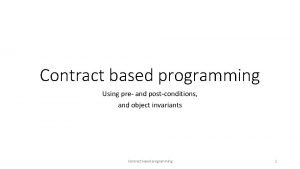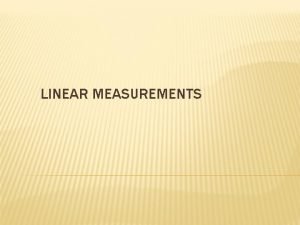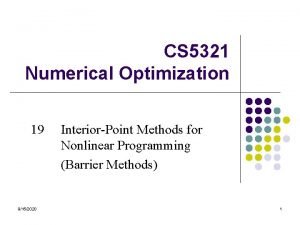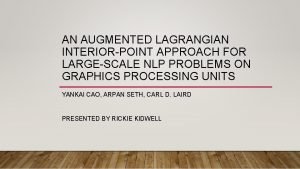Linear Programming InteriorPoint Methods D Eiland Linear Programming









- Slides: 9

Linear Programming Interior-Point Methods D. Eiland

Linear Programming Problem LP is the optimization of a linear equation that is subject to a set of constraints and is normally expressed in the following form : Minimize : Subject to :

Barrier Function To enforce the inequality on the previous problem, a penalty function can be added to Then if any xj 0, then As , then trends toward is equivalent to

Lagrange Multiplier To enforce the constraints, a Lagrange Multiplier (-y) can be added to Giving a linear function that can be minimized.

Optimal Conditions Previously, we found that the optimal solution of a function is located where its gradient (set of partial derivatives) is zero. That implies that the optimal solution for L(x, y) is found when : Where :

Optimal Conditions (Con’t) By defining the vector , the previous set of optimal conditions can be re-written as

Newton’s Method Newton’s method defines an iterative mechanism for finding a function’s roots and is represented by : When ,

Optimal Solution Applying this to following : we can derive the

Interior Point Algorithm This system can then be re-written as three separate equations : Which is used as the basis for the interior point algorithm : 1. Choose initial points for x 0, y 0, z 0 and the select value for τ between 0 and 1 2. While Ax - b != 0 a) Solve first above equation for Δy [Generally done by matrix factorization] b) Compute Δx and Δz c) Determine the maximum values for xn+1, yn+1, zn+1 that do not violate the constraints x >= 0 and z >= 0 from : With : 0 < a <=1
 Van eiland naar wijland
Van eiland naar wijland Www;bingel;be
Www;bingel;be Chapter 7 linear programming solutions
Chapter 7 linear programming solutions Perbedaan linear programming dan integer programming
Perbedaan linear programming dan integer programming Linear vs integer programming
Linear vs integer programming Perbedaan linear programming dan integer programming
Perbedaan linear programming dan integer programming A-wax pattern recognition
A-wax pattern recognition Methods of contract programming
Methods of contract programming Linear convolution using dft
Linear convolution using dft Linear measurement instruments in surveying
Linear measurement instruments in surveying

















